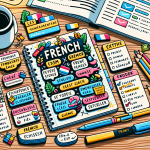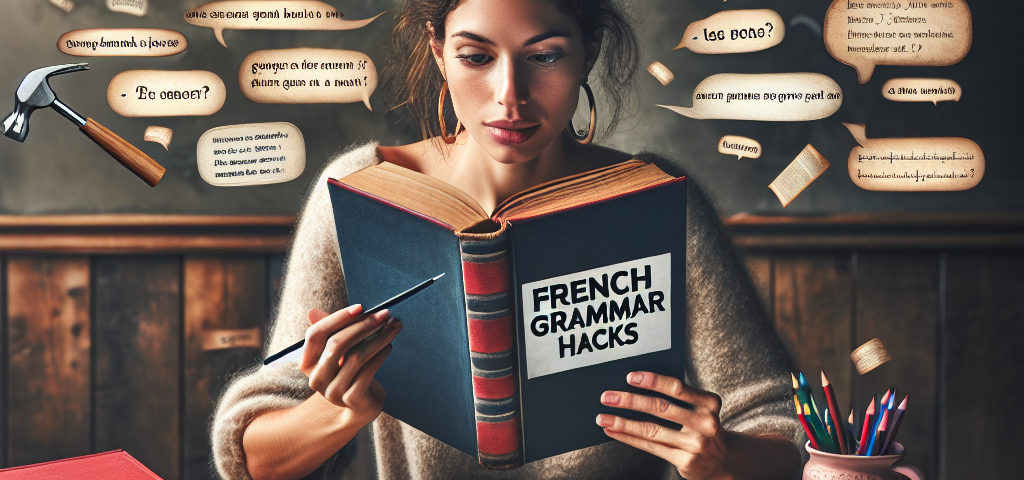
From Vocabulary to Verbs: The Ultimate French Exam Prep Checklist
May 30, 2025
From Bonjour to Au Revoir: Essential Phrases for French Conversation
May 30, 2025
Learning French can be an exciting journey, but it can also be filled with challenges. From verb conjugations to gendered nouns, the intricacies of French grammar often leave learners feeling overwhelmed. Fortunately, there are numerous hacks that can simplify the process and make mastering this beautiful language more accessible. Here are some essential French grammar hacks to help you nail the nuances and elevate your language skills.
1. Gender Awareness
One of the first hurdles in French is mastering the gender of nouns, which can be confusing for new learners. Here’s a simple hack:
Memory Tricks
Use mnemonic devices or associational imagery to remember gendered nouns. For example, associate "la table" (the table) with feminine imagery, like a "lady’s dinner party," while envisioning "le livre" (the book) as a masculine object, perhaps resting on a sturdy "man’s desk." This can help reinforce memory.
Common Patterns
While exceptions abound, many nouns that end in "e" are feminine, while those ending in consonants tend to be masculine. Familiarizing yourself with these patterns can make guessing the gender easier.
2. Conjugation Simplified
French verb conjugations can seem daunting, yet certain strategies can simplify the process:
Regular vs. Irregular
Focus on the most commonly used verbs first, especially when learning regular verbs that follow predictable patterns. For instance, the "er" verbs are the most common and easiest to conjugate.
Conjugation Apps
Use apps or websites that focus on verb conjugations, allowing you to practice in a gamified way. This can make repeating conjugations feel less tedious.
3. Articles and Adjectives
When combining articles and adjectives with nouns, the rules can become slippery. Here are some hacks:
Definite vs. Indefinite Articles
Remember that “le” and “la” are used for specific items (definite articles), while “un” and “une” refer to nonspecific items (indefinite articles).
Adjective Placement
Typically, adjectives follow the nouns they describe in French, but some common ones like "grand" (big) or "petit" (small) precede the noun. A handy tip is to memorize a short list of adjectives that traditionally go before the noun to help you with sentence structures.
4. The Subjunctive Mood
The subjunctive can be one of the most perplexing aspects of French grammar. However, knowing when to use it is essential:
Key Phrases
Recognize phrases that trigger the subjunctive (e.g., "Il faut que" (It is necessary that), "Je veux que" (I want that)). Keeping a list of such expressions handy can save time and confusion.
Practice with Context
Immerse yourself in context-based practice. Engaging with films, songs, and books that incorporate the subjunctive can help you recognize its use organically.
5. Negation Made Simple
French negation often trips learners up, but it’s easier than it seems:
Two-Part Negation
Remember that negation in French typically involves two parts: “ne” and “pas”. An easy hack is to think of it as a "parentheses around the verb." For instance, in the sentence "Je ne mange pas" (I do not eat), visualize those parentheses highlighting the verb.
Familiarize with Variations
Explore variations of negating expressions like “ne… jamais” (never) or “ne… rien” (nothing). Familiarizing yourself with these can enrich your vocabulary while making negation more lively and nuanced.
Conclusion
While French grammar can seem daunting, using these hacks can make learning more manageable and enjoyable. Embrace the nuances, practice consistently, and remember that mistakes are part of the language journey. Each challenge overcome adds to your confidence and proficiency. So grab a French novel, turn on that French rom-com, or try your hand at a conversation with a native speaker. With these tools in your arsenal, you’ll soon find yourself nailing the nuances of the French language!

